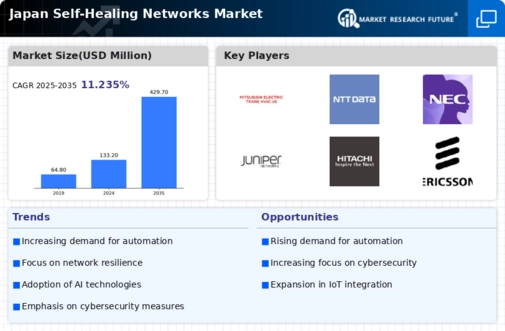Shift Towards 5G Technology
The transition to 5G technology in Japan is poised to drive the self healing-networks market forward. With the rollout of 5G networks, there is an increased demand for systems that can manage the heightened complexity and performance requirements associated with this advanced technology. Self healing capabilities are essential for ensuring that 5G networks can autonomously address issues and maintain service quality. As of November 2025, Japan has made significant strides in 5G deployment, with over 50% of urban areas covered. This expansion is likely to create a robust market for self healing technologies, as telecommunications providers seek to enhance network reliability and user experience in the face of growing data traffic and connectivity demands.
Growing Adoption of IoT Devices
The proliferation of Internet of Things (IoT) devices in Japan is significantly impacting the self healing-networks market. As more devices connect to networks, the complexity and potential for failures increase, necessitating the implementation of self healing technologies. The self healing-networks market is likely to benefit from the expected growth of IoT devices, which is projected to reach over 1 billion units by 2026 in Japan. This surge in connectivity creates a pressing need for networks that can autonomously manage and rectify issues, ensuring seamless operation. Consequently, organizations are increasingly investing in self healing solutions to maintain optimal performance and reliability in their IoT ecosystems.
Rising Demand for Network Reliability
The self healing-networks market in Japan is experiencing a notable surge in demand for enhanced network reliability. As businesses increasingly rely on uninterrupted connectivity, the need for self healing capabilities becomes paramount. This trend is particularly evident in sectors such as telecommunications and finance, where downtime can lead to substantial financial losses. According to recent data, the Japanese telecommunications sector has reported a 15% increase in investments aimed at improving network resilience. This growing emphasis on reliability is driving the self healing-networks market, as organizations seek solutions that can autonomously detect and rectify issues, thereby minimizing service disruptions and enhancing overall operational efficiency.
Government Initiatives for Smart Infrastructure
In Japan, government initiatives aimed at promoting smart infrastructure are significantly influencing the self healing-networks market. The Japanese government has allocated substantial funding towards the development of smart cities, which inherently require robust and resilient network systems. This initiative is expected to boost the self healing-networks market as municipalities and private enterprises invest in technologies that can autonomously manage and repair network faults. Reports indicate that the government plans to invest over ¥1 trillion in smart infrastructure projects by 2027, creating a fertile ground for the self healing-networks market to flourish. Such investments are likely to enhance the adoption of self healing technologies across various sectors, including transportation and utilities.
Increased Cyber Threats and Network Vulnerabilities
The self healing-networks market in Japan is being propelled by the rising incidence of cyber threats and network vulnerabilities. As organizations face an escalating number of cyberattacks, the need for self healing capabilities that can automatically respond to and mitigate these threats becomes increasingly critical. Data suggests that cyber incidents in Japan have surged by approximately 30% over the past year, prompting businesses to seek advanced solutions that can enhance their cybersecurity posture. The self healing-networks market is positioned to address these challenges by providing systems that can autonomously detect anomalies and initiate corrective actions, thereby fortifying network security and resilience.

















Leave a Comment